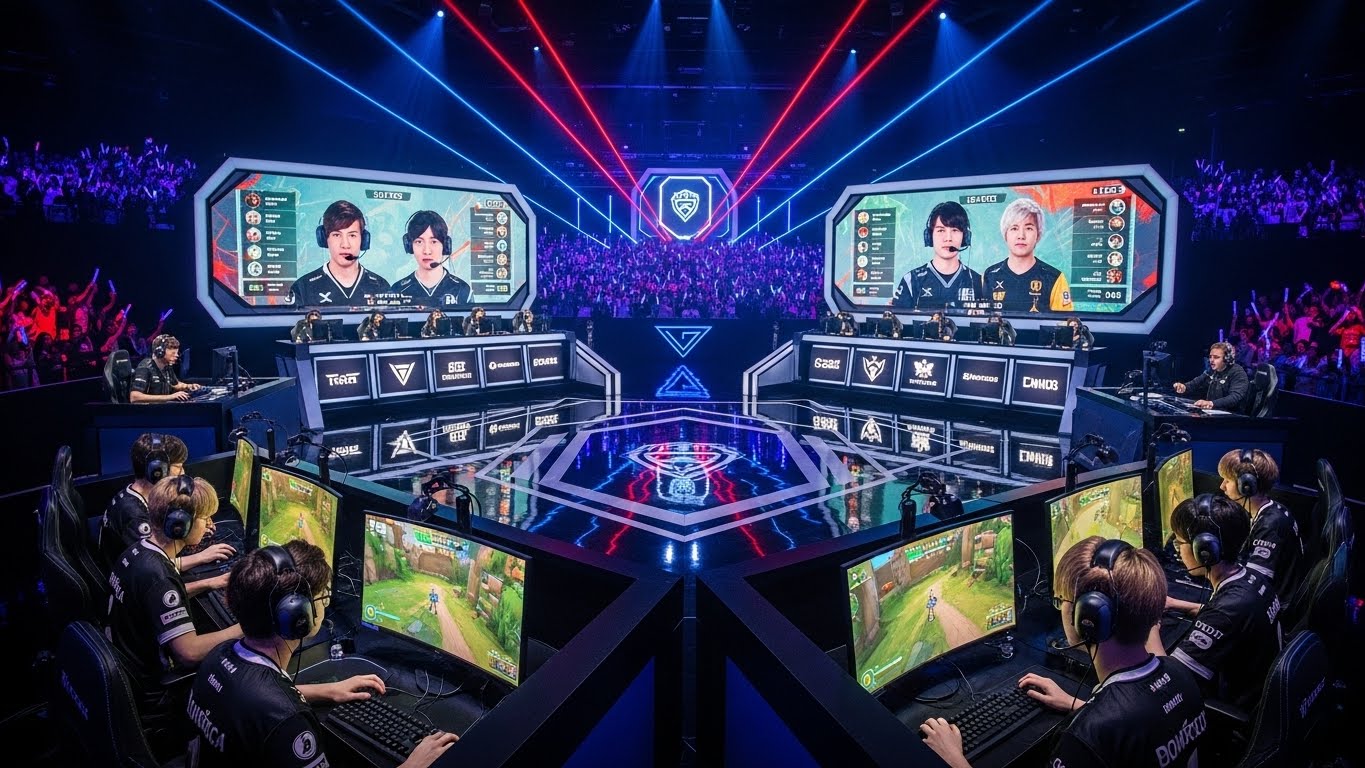Esports has moved from a niche pastime to a major, globally recognized entertainment category in less than two decades. What started as small tournament rooms and online ladders now features stadium events, multi-million-dollar sponsorships, franchised leagues, and state-level investment. But where does the market go from here? This longform post pulls together the latest market estimates, the drivers behind growth, region- and revenue-stream forecasts, plausible scenarios (bull, base, bear), and practical recommendations for stakeholders who want to ride — or hedge — the coming waves.
Quick snapshot (what the data says)
- Industry estimates place the global esports market in the low-to-mid single-billion dollar range today, with multi-year forecasts projecting strong double-digit CAGRs for esports-specific revenues through 2030 under many research scenarios
- Esports sits inside a much larger games and entertainment market (hundreds of billions in consumer spend), and its growth will be strongly influenced by trends across gaming, streaming, advertising and sponsorship.
1) Where we are now: the baseline numbers
Two useful ways to frame the problem: (1) the global games market, and (2) the esports market within it.
- Global games market: industry trackers report overall gaming industry revenue approaching ~$180–190 billion in 2025, driven by mobile, console and PC ecosystems and by big publisher release schedules. Newzoo’s mid-2025 updates place the games market in that neighborhood and highlight that hardware cycles and tentpole releases can push and pull the short-term numbers. Newzoo+1
- Global esports market (esports-specific revenues): recent commercial research firms estimate esports revenue in the low billions today, with different forecasts varying by methodology. One widely cited market research estimate valued the esports market at about USD 2.13 billion in 2024 and projected it could reach ~USD 7.46 billion by 2030 (a high-double-digit percentage aggregate growth over the decade). Other reputable reports predict a 2025 valuation in the ~3–5 billion range depending on what’s included (sponsorship, media rights, streaming revenue share, ticketing, merchandising, and ancillary betting/skins-related revenues).
Why the spread? Different reports use different definitions (some exclude betting or in-game item commerce, others include broader “gaming events” revenue), and forecasts hinge on assumptions about media rights commercialization, sponsorship adoption, and streaming monetization.
2) Core revenue streams and which ones will drive growth
Understanding which revenue buckets will grow fastest is critical to any prediction.
a) Sponsorships & brand partnerships
Historically the largest single esports revenue stream, sponsorships remain central. Brands see esports as a route to younger, highly engaged audiences and are increasingly embedding activations — not just logo placements — into tournaments, content and creators. PwC and other E&M forecasts show sponsorship spending in sports and entertainment growing, which benefits esports as part of that ecosystem.
b) Media rights & streaming
Media rights for live events and exclusive content packages are the next frontier. Unlike traditional sports, streaming platforms — Twitch, YouTube, TikTok creators, and platform exclusives — dominate esports distribution. As audiences become more global and measurement improves, media rights values are expected to rise, though the exact timeline depends on standardized viewership metrics and reliable cross-platform measurement.
c) Merch, ticketing & live events
Event ticketing and on-site merchandise slackened during the COVID era but returned as stadium-scale tournaments resumed. High prize-pool, festival-style events (and even state-backed spectacles) demonstrate the experiential demand for live esports, which supports higher ancillary revenues.
d) Publisher ecosystem & in-game commerce
Game publishers control the competitive calendars and, in some cases, monetization. For titles where publishers operate leagues or take shares of in-game purchases tied to esports fandom, the market capture is significant.
e) Betting, fantasy & secondary monetization
Where legal, betting and fantasy esports products add revenue. Many market reports either exclude or cautiously include these streams because regulatory uncertainty and integrity issues (match fixing, betting-related fraud) make them harder to model.
3) Regional dynamics: where growth will happen
Esports is global, but growth intensity varies by geography.
Asia-Pacific remains the largest and most mature esports market by audience and participation, especially China, South Korea, and Southeast Asia. China’s massive mobile gaming economy underpins much of the region’s scale. North America is strong in sponsorship dollars, franchised leagues, and media rights sophistication. Europe shows steady growth with country pockets (Nordics, UK, Germany) punching above their weight. Emerging regions — Latin America, Middle East & North Africa, and Africa — are fast followers with rising grassroots scenes and increasing investment. Notably, large state-backed projects (for example, major Saudi initiatives and Middle East events) have injected new capital into event prize pools and infrastructure, accelerating regional development in the short ter
4) Drivers behind near-term (1–3 year) growth
Several concrete forces will push esports forward in the near term:
1. Professionalization of leagues and media rights packaging. When leagues standardize metrics and produce TV-grade packages, media rights bids will follow, driving a meaningful revenue layer for organizers and teams.
2. Brand safety, measurement and creative activations. As ad measurement for streaming becomes better and brand safety practices mature, bigger mainstream advertisers will increase allocations.
3. Continued investment in live events. High-profile events are back — and larger — proving that fans will pay for the live experience and that events create high-value sponsorship inventory.
4. Mobile esports growth in developing markets. Mobile titles open massive addressable audiences in regions where consoles/PCs are less pervasive; mobile esports ecosystems can scale quickly through in-game monetization and publisher tournaments.
5. State and private capital inflows. Sovereign wealth, sports investors, and private capital (looking for exposure to culture and content) are placing big bets — both a growth enabler and a source of volatility depending on strategic intent
5) Market predictions — short term (2025–2028) and long term (to 2030)
Multiple reputable research houses converge on the view that esports will grow faster than the broader entertainment sector, but the magnitude differs based on assumptions. Below are three forecast windows: conservative (bear), base, and optimistic (bull).
Base case (most probable under current trends)
- CAGR: ~15–20% for esports-specific revenues through 2025–2030.
- Why: Continued growth in sponsorships, gradual rise in media rights values, expanding regional audiences (mobile-led), stabilized event income. Many research houses use similar mid-range assumptions and outline a multi-billion-dollar valuation by 2030 (Grand View’s scenario of ~USD 7.4B by 2030 is an example of a confident base case).
Bull case (accelerated monetization)
- CAGR: ~20–30%+ through 2030, with market valuations in the high single digits to low double-digit billions by 2030.
- Catalysts: Big, multi-year media rights deals (akin to traditional sports but scaled to esports viewership), explosive brand adoption, legalized and regulated betting/fantasy products contributing materially, and successful publisher-led franchising that unlocks stable league economics.
Bear case (slower adoption / headwinds)
- CAGR: single-digit to low-teens; esports revenues remain below some current higher projections.
- Risks: measurement problems persist (advertisers reluctant), publisher fragmentation (no consistent schedule or rights control), regulatory clampdowns on betting-related revenues, brand retreat due to safety controversies, or macroeconomic contraction reducing marketing budgets.
Concrete numeric scenario example (illustrative):
- If current esports revenues are around USD 2.1B (2024) and follow a 20% CAGR, the market would be ~USD 5.5B by 2028 and ~USD 7.5B by 2030 — aligning with mid-range market reports. If growth is 15% CAGR, 2030 would see ~USD 4.3–5.0B; at 25% CAGR, 2030 could exceed USD 10B. These ranges explain why different research houses publish different headline numbers — methodology and included revenue components matter a lot.
6) Major risks and what could slow growth
No prediction is complete without honesty about downside risks:
1. Measurement & monetization friction. Advertisers need reliable, cross-platform audience measures. If a meaningful standard doesn’t emerge, big ad spending may stay cautious.
2. Publisher control and fragmentation. Esports depends on games; when publishers change rules, patch the game, or pivot competitive support, entire ecosystems can suffer. League structures that over-rely on a single publisher are vulnerable.
3. Regulatory & integrity threats. Betting regulation, match-fixing scandals, and content regulation (e.g., bans or restrictions in large markets) are real threats that could limit certain revenue streams.
4. Macro & ad market cycles. Esports is partly funded by advertising budgets and discretionary consumer spend. Global recessions or marketing pullbacks would reduce sponsorships and media deals.
5. Overcapitalization & misaligned incentives. Rapid influxes of capital (e.g., sovereign investments) can create a bubble of inflated team valuations and unsustainable operating models if long-term monetization lags.
7) Opportunities — where to place bets
If you’re an investor, operator, brand, or creator, the following areas look most promising:
a) Media rights aggregation & measurement tools. Companies that bring measurement and cross-platform attribution to esports viewing will be valuable and may unlock higher media rights fees.
b) Region-specific mobile ecosystems. Investing in mobile esports infrastructure and localized leagues in emerging markets (SEA, LATAM, MENA, Africa) can capture audience growth at lower cost.
c) Creator & team-centric IP. Teams and creators that build diversified IP (merch, music, content series) can generate revenue outside tournament volatility.
d) Event production and experiential activations. High production value live events with cross-border sponsorships remain strong revenue generators when executed well.
e) Regulatory compliance and integrity services. Firms that provide anti-fraud, match integrity and legal guidance to help sponsors feel safe will be in demand.
8) What big stakeholders should do (brands, teams, publishers, investors)
Brands / advertisers
- Move from one-off sponsorships to integrated content partnerships that create measurable outcomes (engagement, product trials).
- Invest in measurement pilots in esports to develop benchmarks and guardrails.
Teams & orgs
- Diversify revenue: build merch, content, creator networks and academies — avoid pure tournament-dependence.
- Build business units to monetize IP and localize fan engagement.
Publishers
- Standardize competitive calendars and measurement data sharing with neutral third-party verification to accelerate media deals.
- Consider hybrid league models that balance open competition with franchised stability.
Investors & funds
- Favor companies unlocking structural problems (measurement, rights, integrity) over speculative team valuations.
- Conduct scenario planning: portfolio exposure should consider both high growth and regulatory/market contraction.
9) Short case studies & real-world signals
Saudi and Gulf investment: Large prize pools and state interest in hosting massive events are changing the landscape quickly. The Esports World Cup and similar initiatives show how state capital can accelerate visibility and infrastructure — but they also raise questions about long-term sustainability and geopolitical optics
Shifts in the games market: Broader gaming industry trends — hardware cycles, delays of tentpole titles, mobile growth — influence esports indirectly. For example, delays of major title releases can depress console sales and dampen adjacent hype cycles; conversely, new global titles can create sudden competitive ecosystems if publishers commit long-term. News outlets and market trackers have pointed to the sensitivity of revenue to title release calendars.
Research divergence: Different market research houses publish different numbers (some projecting 5–7B by 2030, others much higher). This spread is a helpful reminder: treat single numbers with caution and focus on underlying trend direction and drivers.
10) Scenario planning: what to expect year-by-year (practical guide)
This is a compact year-by-year lens — a planning tool rather than a crystal ball.
2025 (near term)
- Expect moderate revenue growth as live events normalize and sponsorship budgets recover post any macro slowdowns. Measurement pilots roll out. Gaming industry headwinds (e.g., delayed AAA releases) create localized softness but not systemic collapse. (Newzoo & other trackers report modest overall market growth for the gaming industry.)
2026–2027 (medium term)
- Potential breakout if multiple media platforms compete for exclusive rights. Franchised leagues may lock in multi-year sponsorship deals. Mobile esports continue to scale in emerging markets. Conversely, unresolved measurement fragmentation could cap upside.
2028–2030 (long term)
- Consolidation and professionalization should produce a mature market structure where media rights, sponsorships and diversified creator income converge to sustain low-double-digit billions in annual revenue (mid-range forecasts center here). High-end outcomes (>$10B) are possible if betting/fantasy are mainstream and publishers coordinate with league operators on rights.
11) Practical advice for smaller players (creators, indie teams, entrepreneurs)
- Creators: Build repeatable formats and direct monetization (subscriptions, tiered communities). Partner with brands on measurable pilots to demonstrate ROI.
- Indie teams: Focus on player development pipelines (academies) and local sponsorships. Keep burn under control; monetize community early.
- Entrepreneurs: Solve infrastructure problems (matchmaking for events, anti-cheat, reliable streaming overlays, rights measurement tools) — these are high-leverage, low-dependency bets.
12) Final assessment: how fast and how big?
Esports will almost certainly grow — the only real question is speed and scope. My summary judgment based on the landscape and multiple reputable research outputs:
- Direction: Positive and upward. The combination of growing global gamers, maturing sponsorship interest, and high-engagement live events forms a powerful growth engine.
- Magnitude: A reasonable base prediction is mid-single-digit to low-double-digit billions by 2030 for esports-specific revenues, with plausible outcomes ranging from ~USD 4–7.5B (mid case) to higher in bullish scenarios if media rights and betting monetize strongly. Several market research houses provide similar mid-range numbers and CAGR assumptions that support this band
- Key determinant: The emergence of industry-wide measurement standards and meaningful, guaranteed media rights deals. Fix those two things and the market accelerates; fail to fix them and growth slows to a steadier crawl.
13) Closing — what to watch next (short checklist)
If you want to track whether forecasts are trending toward the bull or bear case, watch these signals over the next 12–36 months:
- Major multi-year media rights deals announced by leagues or publishers.
- Large sponsorship commitments from mainstream global brands (not just endemic gaming brands).
- Standardized audience measurement accepted by top advertisers/brands.
- Regulatory clarity on esports betting and fantasy in large markets.
- Sustained involvement of publishers in supporting stable competitive calendars.




